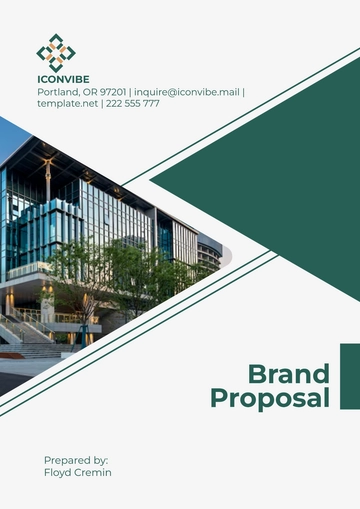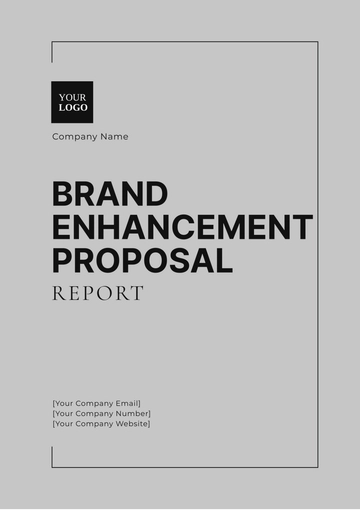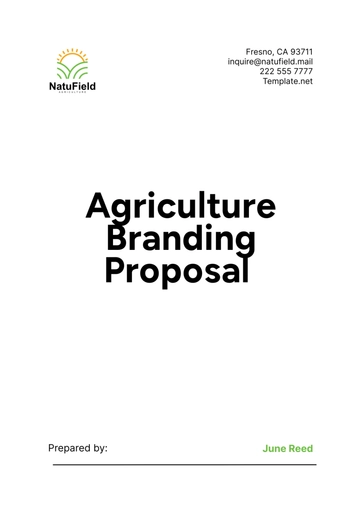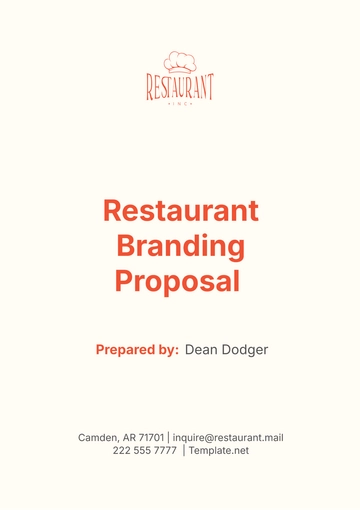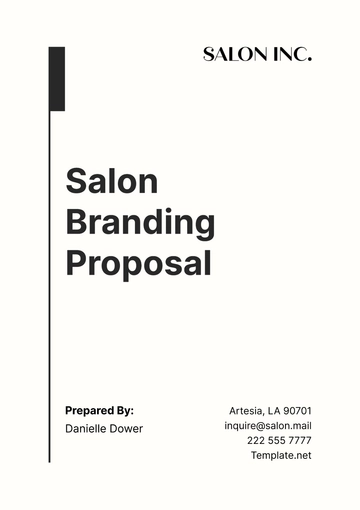Free Restaurant Branding Proposal
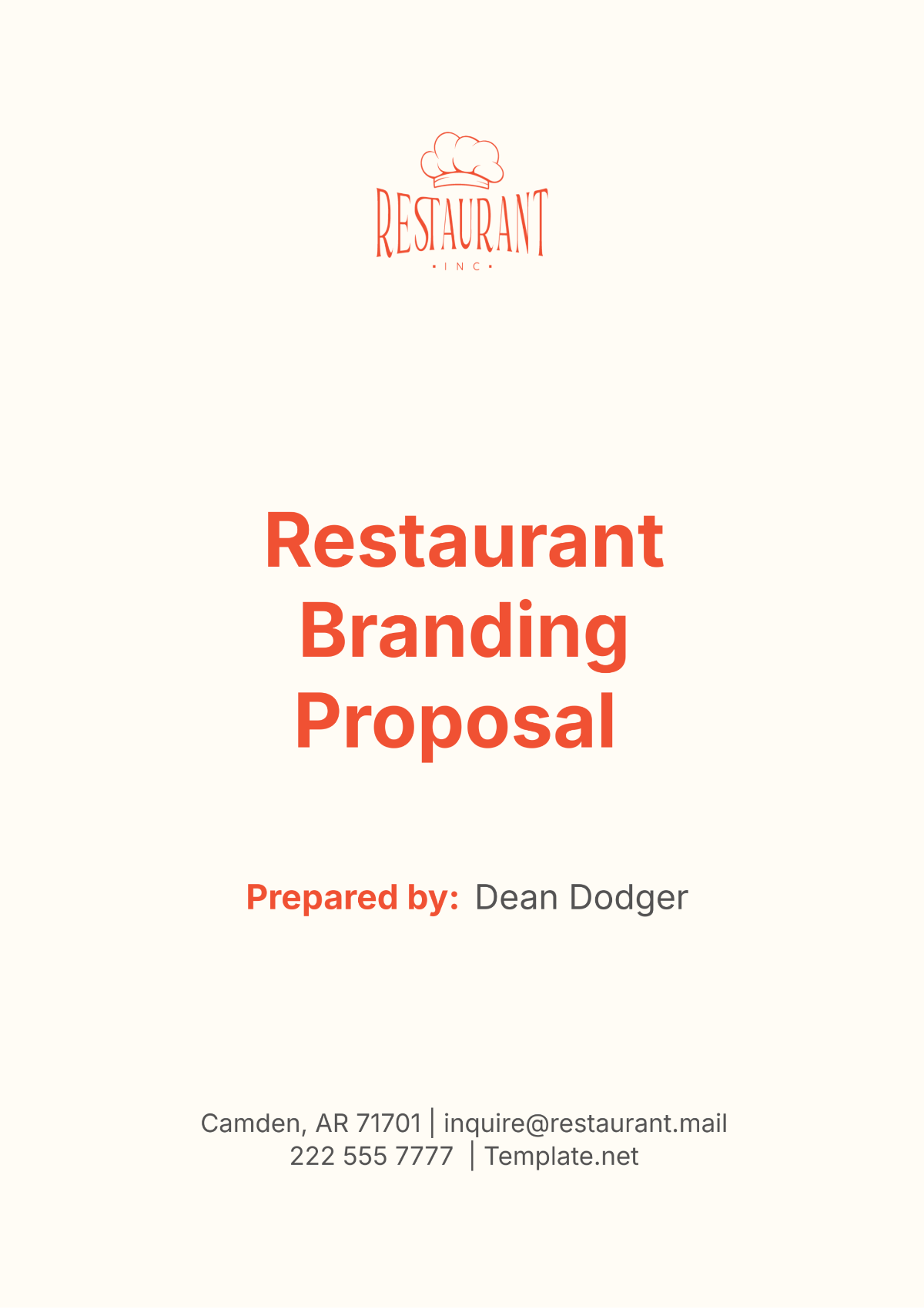
I. Executive Summary
A. Introduction
[Your Company Name] is a premier dining destination offering a unique blend of gourmet cuisine and a welcoming atmosphere. Our restaurant has been a cornerstone in the community for over a decade, known for its high-quality food, exceptional service, and inviting ambiance. As we continue to grow and adapt to changing market trends, it is crucial to refine and strengthen our brand to maintain a competitive edge. This branding proposal aims to outline a comprehensive strategy to enhance our brand identity, improve customer perception, and ensure long-term success.
B. Objectives
The primary objectives of this branding proposal are:
To establish a clear and distinctive brand identity that resonates with our target audience.
To enhance brand visibility and recognition both online and offline.
To create a consistent and memorable customer experience that fosters loyalty and word-of-mouth promotion.
To differentiate [Your Company Name] from competitors through unique selling propositions and a compelling brand story.
To align all branding efforts with our business goals and values.
II. Brand Analysis
A. Current Brand Status
Currently, [Your Company Name] has a well-recognized logo and a color scheme that reflects our commitment to quality and sophistication. Our brand messaging emphasizes our dedication to fresh ingredients, culinary excellence, and exceptional service. However, there are areas where our brand can be further developed to enhance consistency and impact across all customer touchpoints.
Current Brand Elements:
Logo: A classic design featuring the restaurant's name in elegant typography.
Colors: A palette of rich earth tones that evoke warmth and comfort.
Messaging: Emphasis on quality, freshness, and a memorable dining experience.
Current Brand Perception and Market Position:
Strengths: Strong reputation for food quality and service, loyal customer base, favorable online reviews.
Weaknesses: Inconsistent branding across digital platforms, limited social media engagement, outdated visual elements.
Opportunities: Growing interest in local and sustainable dining, the potential to leverage digital marketing for broader reach.
Threats: Increasing competition from new restaurants, changing consumer preferences, and economic fluctuations.
B. SWOT Analysis
Strengths | Weaknesses |
|---|---|
Established a reputation for quality | Inconsistent branding across platforms |
Loyal customer base | Limited social media presence |
High customer satisfaction | Outdated visual elements |
Opportunities | Threats |
|---|---|
Growing interest in sustainable dining | Increasing competition |
Potential for digital marketing expansion | Changing consumer preferences |
Collaboration with local suppliers | Economic fluctuations |
III. Target Audience
A. Demographic Analysis
Understanding our target audience is crucial for effective branding. Our primary demographic includes:
Age: 25-55 years old
Gender: Male and female
Income Level: Middle to upper-middle class
Education: College-educated
Location: Local residents and tourists
B. Psychographic Analysis
Our target audience values quality dining experiences and is willing to pay a premium for exceptional food and service. They appreciate unique and memorable experiences, and they often seek out restaurants that align with their lifestyle and values.
Interests: Culinary arts, food and wine tasting, health and wellness
Lifestyle: Busy professionals, food enthusiasts, health-conscious individuals
Values: Quality, authenticity, sustainability, community
C. Behavioral Analysis
Behavioral factors provide insights into the spending habits and preferences of our target audience. This information helps us tailor our branding and marketing efforts to better meet their needs.
Spending Habits: Willing to spend on premium dining experiences, values special occasions and events
Dining Preferences: Prefers fresh, locally-sourced ingredients, enjoys trying new dishes and flavors
Engagement: Active on social media, reads online reviews, engages with brands that share their values
IV. Brand Positioning
A. Unique Selling Proposition (USP)
Our USP is centered around offering an unparalleled dining experience that combines gourmet cuisine with a warm and inviting atmosphere. We pride ourselves on using the freshest, locally-sourced ingredients to create dishes that are both innovative and comforting.
Freshness: We source our ingredients from local farms and suppliers to ensure the highest quality and sustainability.
Culinary Excellence: Our chefs are passionate about creating dishes that are both delicious and visually stunning.
Atmosphere: Our restaurant provides a cozy and elegant setting that makes every visit special.
B. Brand Promise
At [Your Company Name], we promise to deliver an exceptional dining experience that exceeds expectations. Our commitment to quality, service, and community is unwavering, and we strive to create a welcoming environment where every guest feels valued.
C. Brand Personality
Our brand personality reflects the qualities we want our customers to associate with [Your Company Name]:
Welcoming: Friendly and inviting, making every guest feel at home.
Sophisticated: Elegant and refined, with attention to detail in every aspect.
Authentic: Genuine and honest, with a focus on real ingredients and sincere service.
Innovative: Creative and forward-thinking, always looking for new ways to delight our guests.
D. Competitive Analysis
Understanding our competitors' strengths and weaknesses helps us identify opportunities for differentiation. Key competitors include:
Competitor A: Known for its trendy atmosphere and innovative menu but lacks consistency in service.
Competitor B: Offers a wide variety of dishes but does not emphasize local sourcing or sustainability.
Competitor C: Popular for its affordability and convenience but does not provide a high-end dining experience.
By focusing on our strengths—fresh, locally-sourced ingredients, culinary excellence, and a welcoming atmosphere—we can position [Your Company Name] as the premier choice for discerning diners.
V. Brand Identity
A. Visual Identity
A strong visual identity is essential for brand recognition and consistency. Our visual identity elements include:
Logo Design and Usage:
Our logo features a classic design with elegant typography that reflects the sophistication of our brand.
Usage Guidelines: The logo should be used consistently across all materials, maintaining its proportions and colors.
Color Palette:
Primary Colors: Deep burgundy, warm beige, rich brown
Accent Colors: Soft gold, olive green
These colors evoke warmth, comfort, and a connection to nature.
Typography:
Primary Font: A serif typeface for a classic and sophisticated look.
Secondary Font: A sans-serif typeface for readability and modernity in body text.
Imagery and Photography Style:
High-quality images showcasing our dishes, interior, and local suppliers.
Photography style should be natural, warm, and inviting, capturing the essence of our dining experience.
B. Brand Voice and Tone
Our brand voice is the personality of our communication, and it should be consistent across all platforms.
Language Style and Communication Approach:
Warm and Welcoming: Friendly and approachable language that makes guests feel valued.
Sophisticated: Elegant and refined language that reflects our high standards.
Authentic: Genuine and honest communication that builds trust.
Messaging Guidelines for Various Platforms:
Social Media: Engaging and interactive content that encourages participation and sharing.
Website: Clear and informative content that highlights our menu, philosophy, and values.
Advertising: Compelling and creative messaging that emphasizes our unique selling points.
VI. Brand Touchpoints
A. In-Restaurant Experience
The in-restaurant experience is crucial to reinforcing our brand identity and creating a memorable experience for our customers. Each touchpoint within the restaurant should reflect our commitment to quality, authenticity, and customer satisfaction.
Interior Design and Decor:
Theme and Ambiance: Our restaurant’s interior should reflect a warm, welcoming, and sophisticated ambiance. The use of natural materials such as wood and stone, combined with soft lighting and comfortable seating, will create an inviting atmosphere.
Decor Elements: Artwork and decor should showcase local culture and culinary themes. This includes framed photographs of local farms, vintage kitchen utensils, and tasteful wall art that echoes our brand’s commitment to quality and sustainability.
Menu Design and Presentation:
Menu Layout: The menu should be easy to navigate, with clear sections for appetizers, main courses, desserts, and beverages. Each dish should be described in a way that highlights its ingredients and preparation.
Material and Aesthetics: Use high-quality, durable materials for the menus. A combination of rich textures and elegant fonts will convey sophistication and attention to detail.
Seasonal Specials: Highlight seasonal dishes and local ingredients prominently to emphasize our commitment to freshness and sustainability.
Staff Uniforms and Appearance:
Uniform Design: Staff uniforms should be stylish yet comfortable, featuring colors that align with our brand palette. Consider incorporating the restaurant’s logo subtly into the design.
Grooming Standards: Staff should maintain a professional appearance at all times. This includes well-groomed hair, minimal jewelry, and clean, pressed uniforms.
Customer Interaction: Staff should be trained to engage with customers warmly and professionally, reflecting the welcoming and sophisticated nature of our brand.
B. Digital Presence
In today’s digital age, a strong online presence is essential for reaching and engaging with our target audience. Our digital touchpoints must be cohesive, user-friendly, and reflective of our brand values.
Website Design and Functionality:
Visual Appeal: The website should feature high-quality images and a clean, modern design. Use our brand colors and typography consistently.
User Experience: Ensure easy navigation with clear menus and an intuitive layout. Important information such as the menu, location, hours of operation, and contact details should be easily accessible.
Content: Include engaging content such as the story behind [Your Company Name], chef profiles, and blog posts about local ingredients and seasonal dishes.
Social Media Strategy and Content:
Platforms: Focus on platforms where our target audience is most active, such as Instagram, Facebook, and Twitter.
Content Types: Share a mix of content including high-quality images of dishes, behind-the-scenes looks at the kitchen, staff spotlights, and customer testimonials.
Engagement: Respond to comments and messages promptly. Encourage user-generated content by hosting photo contests or asking customers to share their dining experiences.
Online Reviews and Reputation Management:
Monitoring: Regularly monitor review sites such as Yelp, Google Reviews, and TripAdvisor.
Response Strategy: Respond to reviews, both positive and negative, in a timely and professional manner. Thank customers for positive feedback and address any concerns raised in negative reviews constructively.
Encouraging Reviews: Encourage satisfied customers to leave reviews. This can be done through in-restaurant prompts, follow-up emails, or social media.
C. Marketing and Advertising
Effective marketing and advertising are crucial for building brand awareness and attracting new customers. Our campaigns should be creative, consistent, and aligned with our brand values.
Print and Digital Advertising:
Print Ads: Utilize local newspapers, magazines, and flyers to reach the community. Ensure that the design is consistent with our brand identity, featuring high-quality images and compelling copy.
Digital Ads: Use targeted online ads on platforms such as Google Ads and social media. These ads should be visually appealing and include clear calls to action.
Promotional Materials:
Flyers and Banners: Design promotional materials for special events, new menu launches, and seasonal promotions. These should be eye-catching and informative.
Merchandise: Offer branded merchandise such as tote bags, T-shirts, and mugs. This not only promotes the brand but also provides an additional revenue stream.
Partnerships and Sponsorships:
Local Collaborations: Partner with local businesses, farms, and events to increase brand visibility and reinforce our commitment to the community.
Sponsorships: Sponsor local events, festivals, and charity functions to enhance our reputation and connect with potential customers.
VII. Implementation Plan
A. Timeline
A well-structured timeline is essential for the successful implementation of our branding initiatives. This timeline outlines key phases and milestones to ensure timely and efficient execution.
Phase | Activities | Timeline |
|---|---|---|
Phase 1: Planning | Conduct brand audit Develop branding strategy Set objectives and KPIs | Month 1 |
Phase 2: Design | Redesign logo and visual identity Update menu and uniform designs Revamp website and social media | Months 2-3 |
Phase 3: Rollout | Launch new branding elements Train staff on new brand standards Begin marketing campaigns | Months 4-6 |
Phase 4: Evaluation | Monitor brand performance Collect customer feedback Adjust strategies as needed | Ongoing from Month 7 |
B. Budget
A detailed budget ensures that resources are allocated effectively and that all branding initiatives are financially feasible.
Category | Estimated Cost |
|---|---|
Logo and Visual Identity Redesign | $5,000 |
Menu and Uniform Design | $3,000 |
Website Development | $10,000 |
Social Media and Digital Marketing | $7,000 |
Print Advertising | $2,000 |
Promotional Materials | $3,000 |
Partnerships and Sponsorships | $5,000 |
Staff Training | $2,000 |
Contingency | $3,000 |
Total | $40,000 |
VIII. Measurement and Evaluation
A. Key Performance Indicators (KPIs)
To measure the success of our branding efforts, we will track a range of KPIs. These metrics will help us understand how well our branding strategies are performing and where adjustments may be needed.
KPI | Description | Target |
|---|---|---|
Brand Awareness | Measured through social media reach and engagement | 20% increase in followers and engagement within 6 months |
Customer Satisfaction | Measured through customer feedback and online reviews | Achieve an average rating of 4.5 stars or higher on review sites |
Sales Growth | Increase in revenue from both new and returning customers | 15% increase in revenue within 6 months |
Website Traffic | Number of visitors to the website and their engagement levels | 25% increase in website traffic and time spent on the site |
Return on Investment (ROI) | Financial return from marketing and branding activities | Achieve ROI of at least 150% |
B. Feedback Mechanisms
Collecting feedback from customers and employees is essential for continuous improvement. We will use various methods to gather and analyze feedback.
Customer Surveys: Distribute surveys via email and in-restaurant to gather insights on customer satisfaction and suggestions for improvement.
Comment Cards: Provide comment cards at tables for immediate customer feedback.
Online Reviews: Monitor and analyze reviews on platforms such as Yelp, Google, and TripAdvisor.
Employee Feedback: Conduct regular staff meetings and surveys to gather insights from employees on customer interactions and operational efficiency.
C. Continuous Improvement
Based on the feedback and performance data, we will continuously refine our branding strategies to ensure they remain effective and relevant.
Regular Reviews: Conduct quarterly reviews of branding performance and adjust strategies as needed.
Innovation and Adaptation: Stay updated on industry trends and incorporate new ideas and technologies to keep the brand fresh and appealing.
Training and Development: Provide ongoing training for staff to ensure they are equipped to deliver the best customer experience aligned with our brand values.
IX. Conclusion
A. Summary of Proposal
This branding proposal outlines a comprehensive strategy to enhance the brand identity of [Your Company Name]. By focusing on key areas such as visual identity, customer experience, digital presence, and marketing, we aim to create a cohesive and compelling brand that resonates with our target audience. The proposed implementation plan ensures that all branding initiatives are executed efficiently, within budget, and with measurable results.
B. Call to Action
We are excited about the potential of this branding strategy to elevate [Your Company Name] to new heights. We recommend moving forward with the proposed plan to achieve our branding objectives and secure our position as a leading dining destination. The next step is to approve the proposal and commence the planning phase. Together, we can create a brand that not only stands out but also drives long-term success.
- 100% Customizable, free editor
- Access 1 Million+ Templates, photo’s & graphics
- Download or share as a template
- Click and replace photos, graphics, text, backgrounds
- Resize, crop, AI write & more
- Access advanced editor
Enhance your brand identity with Template.net's Restaurant Branding Proposal Template. This customizable and editable template, accessible through the Ai Editor Tool, helps you create a comprehensive branding strategy. Personalize it to reflect your restaurant’s unique personality and values. Develop a professional branding proposal to effectively communicate your vision and attract more customers, ensuring a strong and memorable brand presence.
You may also like
- Business Proposal
- Research Proposal
- Proposal Request
- Project Proposal
- Grant Proposal
- Photography Proposal
- Job Proposal
- Budget Proposal
- Marketing Proposal
- Branding Proposal
- Advertising Proposal
- Sales Proposal
- Startup Proposal
- Event Proposal
- Creative Proposal
- Restaurant Proposal
- Blank Proposal
- One Page Proposal
- Proposal Report
- IT Proposal
- Non Profit Proposal
- Training Proposal
- Construction Proposal
- School Proposal
- Cleaning Proposal
- Contract Proposal
- HR Proposal
- Travel Agency Proposal
- Small Business Proposal
- Investment Proposal
- Bid Proposal
- Retail Business Proposal
- Sponsorship Proposal
- Academic Proposal
- Partnership Proposal
- Work Proposal
- Agency Proposal
- University Proposal
- Accounting Proposal
- Real Estate Proposal
- Hotel Proposal
- Product Proposal
- Advertising Agency Proposal
- Development Proposal
- Loan Proposal
- Website Proposal
- Nursing Home Proposal
- Financial Proposal
- Salon Proposal
- Freelancer Proposal
- Funding Proposal
- Work from Home Proposal
- Company Proposal
- Consulting Proposal
- Educational Proposal
- Construction Bid Proposal
- Interior Design Proposal
- New Product Proposal
- Sports Proposal
- Corporate Proposal
- Food Proposal
- Property Proposal
- Maintenance Proposal
- Purchase Proposal
- Rental Proposal
- Recruitment Proposal
- Social Media Proposal
- Travel Proposal
- Trip Proposal
- Software Proposal
- Conference Proposal
- Graphic Design Proposal
- Law Firm Proposal
- Medical Proposal
- Music Proposal
- Pricing Proposal
- SEO Proposal
- Strategy Proposal
- Technical Proposal
- Coaching Proposal
- Ecommerce Proposal
- Fundraising Proposal
- Landscaping Proposal
- Charity Proposal
- Contractor Proposal
- Exhibition Proposal
- Art Proposal
- Mobile Proposal
- Equipment Proposal
- Student Proposal
- Engineering Proposal
- Business Proposal
